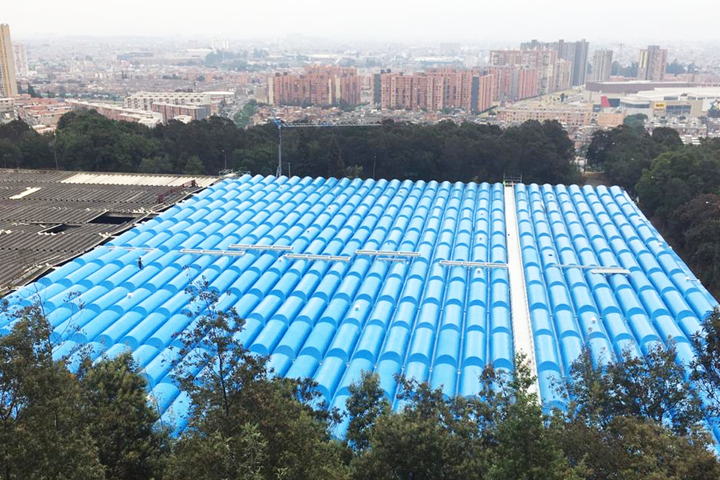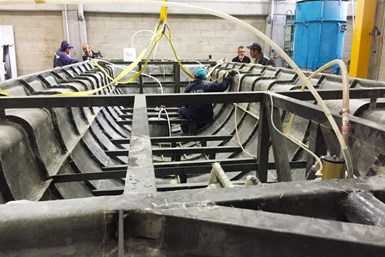Soling, Magnum Venus Products partnership produces LRTM composite domes
Incorporating the LRTM process enabled Soling to produce the largest LRTM part by volume manufactured in Colombia.

Aerial view of the completed phase one project to develop water storage tanks for Bogota Water Utility. Source | MVP
Magnum Venus Products (MVP, Knoxville, Tenn., U.S.) and its Colombian distributor, Minepro SAS (Medellin, Colombia) reported its collaboration with Innovative Engineering Solutions (Soling, Colombia), a company dedicated to providing corrosion solutions, to develop drinking water storage tanks for Bogota’s water utility company.
Soling was initially presented with the project in 2018 to develop a 143-meter-by-109-meter (149-foot-by-358-foot) drinking water storage tank, as the water utility company’s current operation had frequent aqueduct cover breaks requiring costly repairs and thus, increased risk of potable water contamination. Although Soling proposed a series of 7.6-meter-by-2.4-meter (25-foot-by-8-foot) semicircular domes, with a surface area of approximately 207 square feet per piece, it was soon realized that Soling would be required to manufacture 840 domes in order to cover the total project area. Partnering with MVP enabled both teams to devise an effective process to reach a high production throughput with very low post-processing requirements. Furthermore, Soling was already familiar with MVP, having relied on its equipment to provide solutions for its customers.
According to MVP, the Bogota Water Utility project required the manufacturing of up to eight 320- kilogram pieces per day, a net increase in consumption of more than two tons of resin per day. To meet the need for a highly repeatable process producing good surface finish with isophthalic gelcoat on both sides, MVP recommended vacuum-assisted closed molding, or light resin transfer molding (LRTM) as the most suitable process.
MVP used its Patriot Innovator High Volume RTM System which, designed for injecting polyester, vinyl ester and methacrylate resins and catalyst at controlled pressures, is capable of injecting material at a high rate with a single unit. The injection was performed with the LRTM process, consisting of high-volume turbo autosprue valves (TAS), universal couplings, seals and mold accessories. A low viscosity resin formulated by Colombian chemical manufacturer, Andercol Co. (Antioquia, Colombia), is said to have been incorporated.

Mold developed by Soling and MVP used in manufacture of new storage domes. Source | MVP
According to MVP, the full production cycle for one piece, from the preparation of the mold to the extraction of each dome, took four hours with an injection time of only 40 minutes. In an eight-hour work shift, two pieces were able to be manufactured from the application of gelcoat — using MVP’s multicolor gelcoat system — to the trimmed and finished piece, ready for shipment.
These new composite dome covers are expected to last much longer than those previously built with traditional materials, contends MVP, which were prone to breakage and carried huge maintenance costs for Bogota’s water utility company. The company notes that the success of this project has raised the bar on size, efficiency and production volume for the composites industry in Colombia.
To date, MVP says the Bogotá aqueduct domes are the largest parts by volume manufactured through a LRTM process in Colombia. The full implementation of the project is said to have taken only six months thanks to the collaborative effort between itself, Minepros SAS, Soling and Andercol; MVP’s team, including Latin America sales manager Andrés F. Collazos, and technical specialist Herik Navarro, provided critical equipment expertise and technical support. MVP’s distributor in Colombia, Minepro SAS, coordinated many of the engineering, sales and technical aspects during the process implementation, including equipment and fine-tuning of the LRTM process. On the materials side, Andrés Franco and the service and technical development team in R&D at Andercol, also played a key role in the formulation of the low-viscosity resin, as well as early support with key design elements of the process. Additionally, Soling’s engineering team, led by Rodrigo Vergara, was in charge of integrating all information and data, and setting up the process.
“Partners like MVP enable us to bring these projects to life and deliver effective solutions. Their customer service and technical expertise is second to none,” says Soling engineer, Javier Moreno.
“Through this collaboration, we were able to redefine what is possible for the local industry.” Soling says it is planning to continue producing covers for the second stage of the project and explore more MVP closed molding solutions for even higher manufacturing volumes of various large-scale composite parts.
Read the full case study here.
Related Content
Bladder-assisted compression molding derivative produces complex, autoclave-quality automotive parts
HP Composites’ AirPower technology enables high-rate CFRP roof production with 50% energy savings for the Maserati MC20.
Read MorePrepreg compression molding supports higher-rate propeller manufacturing
To meet increasing UAV market demands, Mejzlik Propellers has added a higher-rate compression molding line to its custom CFRP propeller capabilities.
Read MoreCOMPINNOV TP2 project promotes use of thermoplastics in aerospace
Completed in 2023, COMPINNOV TP2 explored thermoplastic composites, enhancing the understanding between prepregs and production methods to foster the potential for French aerospace innovation.
Read MoreClean Sky 2 outer wing box demonstrator validates OOA LRI, shimless assembly and SHM
Full-scale wing box project achieves TRL 5 with 2% weight reduction and 4% reduction in recurring production costs through improved manufacturing efficiency and assembly processes.
Read MoreRead Next
Ceramic matrix composites: Faster, cheaper, higher temperature
New players proliferate, increasing CMC materials and manufacturing capacity, novel processes and automation to meet demand for higher part volumes and performance.
Read MoreNext-gen fan blades: Hybrid twin RTM, printed sensors, laser shock disassembly
MORPHO project demonstrates blade with 20% faster RTM cure cycle, uses AI-based monitoring for improved maintenance/life cycle management and proves laser shock disassembly for recycling.
Read MoreUltrasonic welding for in-space manufacturing of CFRTP
Agile Ultrasonics and NASA trial robotic-compatible carbon fiber-reinforced thermoplastic ultrasonic welding technology for space structures.
Read More


























